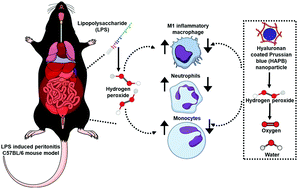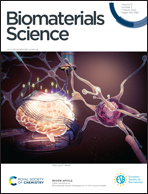Hyaluronan-coated Prussian blue nanoparticles relieve LPS-induced peritonitis by suppressing oxidative species generation in tissue-resident macrophages†
Abstract
Excessive inflammatory response during sepsis causes irreversible damage to healthy tissues and results in multi-organ failure. During infection, bacterial endotoxin-triggered inflammatory responses in macrophages facilitate the recruitment of circulating leukocytes, including neutrophils and monocytes. A key component that aggravates the systemic inflammatory response is the generation of stable reactive oxygen species such as hydrogen peroxide (H2O2). In this study, we present a versatile strategy to reduce the activation of tissue-resident macrophages and prevent leukocyte infiltration in an LPS-induced endotoxemia model. We designed and synthesized hyaluronic acid-stabilized Prussian blue (HAPB) nanoparticles and validated their activity in the dismutation of H2O2 in LPS-induced tissue-resident macrophages. Hyaluronic acid provided stability and enhanced the intracellular uptake of insoluble Prussian blue via the CD44 receptor on LPS-activated macrophages. Following HAPB administration to an LPS-induced peritonitis murine model, the level of M1 inflammatory macrophage population decreased, and the infiltration of neutrophils along with monocytes was suppressed. Overall, we have developed biocompatible Prussian blue nanoparticles to ameliorate inflammatory stress in LPS-induced endotoxemia by scavenging the intracellular peroxide thereby inhibiting inflammatory cascade in tissue-resident macrophages. Therefore, HAPB nanoparticles may potentially be used as novel nano-stress relievers in sepsis. The nanomaterials may have clinical application in sepsis and in other inflammatory diseases involving peroxides as key inflammatory agents.



 Please wait while we load your content...
Please wait while we load your content...